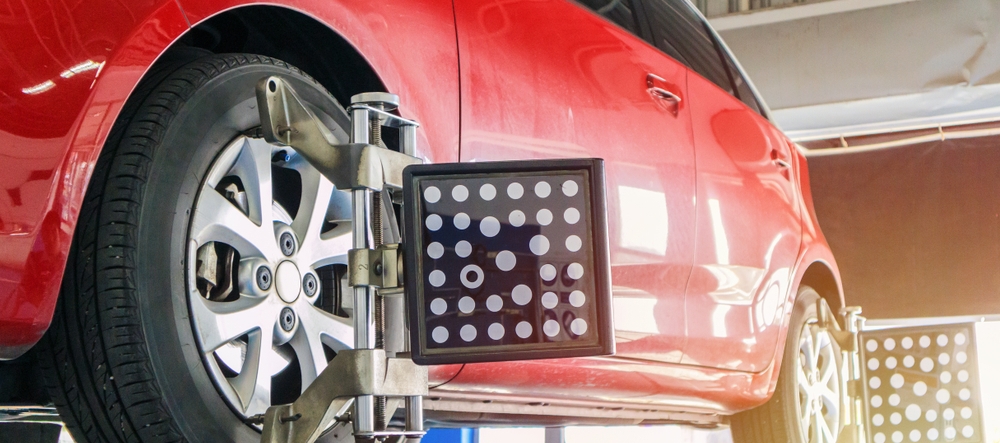
30 Apr Wheel Alignment | Auto Stability Triangle Part 3
 Welcome to part 3 of the auto stability triangle blog series. The suspension, wheel alignment, and tires are the three sides of the auto stability triangle. In this blog, we will concentrate on wheel alignment. Below I will explain what wheel alignment is and how it contributes to auto stability. Additionally, I’ll discuss common symptoms of misalignment (like car shaking & tire wear) and suggest when to schedule a wheel alignment service.
Welcome to part 3 of the auto stability triangle blog series. The suspension, wheel alignment, and tires are the three sides of the auto stability triangle. In this blog, we will concentrate on wheel alignment. Below I will explain what wheel alignment is and how it contributes to auto stability. Additionally, I’ll discuss common symptoms of misalignment (like car shaking & tire wear) and suggest when to schedule a wheel alignment service.
What Is Wheel Alignment?
Wheel Alignment ensures the angle of the wheels is parallel to each other and perpendicular to the ground. The stability of your automobile relies on all four tires gripping the road and traveling in the same direction at the same rate. There are different types of wheel alignment. Which type of alignment you need will depend on your vehicle’s make & model.
Four-Wheel Total Alignment
Four-Wheel Total Alignment provides vehicles with independent rear suspension adjustments on both the front and rear axles. The axles are calibrated to the vehicle’s center, ensuring the automobile will drive straight with the steering wheel centered.
Two-Wheel or Front End Alignment
A Two-Wheel or Front-End Alignment orients only the two front wheels in relation to each other. It does account for the position of the rear axle.
Thrust-Angle Alignment
A Thrust-Angle Alignment involves vehicles with a solid rear drive axle that do not have adjustable alignment. A technician will set the angles of the front alignment parallel to the rear wheels.
When To Schedule Wheel Alignment
There are many occasions where scheduling a wheel alignment is necessary for your vehicle. I have detailed some examples below. Failing to maintain proper wheel alignment can impact your vehicle’s ride quality, stability, and safety.
Routine Maintenance
Factory recommendations for wheel alignment vary by vehicle make & model. Intervals can be anywhere from every 6,000 miles to once every two years. Always follow the routine maintenance guidelines outlined in your owner’s manual. Ask your service technician for recommendations if your manual does not offer a wheel alignment maintenance interval.
Tire Wear
Generally speaking, when your wheels are aligned, the tires should wear evenly across the surface of the tread. If you see uneven tread, schedule a service to determine the cause. Here are a few issues to look for:
- Cupped Wear – Tread may be missing or worn in scattered areas across the surface. This indicates the tire bounces on the road surface due to the caster angle, an unbalanced tire, or suspension issues.
- Feathered Wear – The tire tread has pointed or jagged edges. This indicates the toe angle is off.
- Shoulder Wear – One side of the tire is more worn than the other. This indicates the camber angle is off.
Tire Replacement
Most auto manufacturers recommend a wheel alignment when you have new tires installed or worn suspension parts replaced.
Collisions or Potholes
Everyday driving can cause misalignment over time. Especially if you drive in rough terrain, go off-road, or routinely bump the curb while parallel parking. Check the wheel alignment if you have a fender-bender or hit a pothole hard.
Common Symptoms of Misalignment
Wheel alignment is an essential part of the auto stability triangle. The suspension depends on the wheels and tires to provide adequate traction and handling. When one of the legs of the stability triangle needs service, you may see the symptoms in more than one of the systems and components. Misalignment may cause the following symptoms:
- Uneven tire tread wear
- Vehicle pulls or swerves to one side while driving straight
- Wheels point in different directions
- Steering wheel is off center
- Car shaking or vibrating when driven
Benefits of Wheel Alignment
Below are some of the many benefits of proper wheel alignment:
- Enhanced vehicle performance
- Increased driving comfort
- Improved handling & stability
- Safer driving conditions
- Longer tire life
- Better traction
- Prevents excessive wear on suspension components
- Increased fuel economy
- Less wear & tear on tires and suspension parts
Where To Schedule Wheel Alignment
Plymouth Auto & Tire Center provides a printout of your alignment readings before and after we complete the wheel alignment service. Auto manufacturers carefully specify calculated adjustments and precise settings for wheel alignments. Our ASE Certified Technicians will reset all the settings to the manufacturer’s specifications. Protect your investment by keeping your vehicle’s wheels aligned.
Make An Appointment
Call Plymouth Auto & Tire Center today at (610) 825-6558 or visit us online to make your wheel alignment appointment today!
Next Up in Blog Series
Auto Stability Triangle Part 4 | Tires

